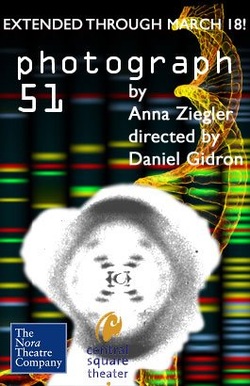Lessons From Rosalind Franklin in Photograph 51
April 17, 2012
By Alison Liou In the spirit of exploring the female role in different settings, the Nora Theatre Company recently gave several performances of Photograph 51, a play about Rosalind Franklin, at the Central Square Theater in Cambridge, MA. Photograph 51, by Anna Ziegler, is a play about Franklin’s life as a young scientist at King’s College in London after World War II. The play is named after the DNA image Franklin captured during her time in London that contributed to the eventual discovery of the structure of DNA, or “the secret of life”. After earning her PhD at 26 years old and spending three years abroad in France, Franklin was invited to King’s College to apply her knowledge of x-ray diffraction, a technique for imaging crystalline solids, to DNA. As a woman in the overwhelmingly male-dominated field of science, she was, naturally, looked-down upon by her male colleagues. Upon her arrival, for instance, Franklin was unhappy to find out that the general assumption was that she would be assisting Dr. Maurice Wilkins, as opposed to pursuing her own independent project alongside him. Although Franklin was able to work against the odds and stand up for her worth, her rocky start and strained relationships at the college—a result of her coldness toward others and temperamental ways according to the play—would work against her later on in the race to discover the structure of DNA. Although no one portrayal can fully and accurately depict the person that Franklin was and the life that she lived, Photograph 51’s description of her experiences and portrayal of her as a “self-less researcher devoted to science, feminist icon bucking the established male scientific bulwark, wronged colleague, temperamental and unreasonable crank, scientist of the highest order”, as described by artistic director Mary C. Huntington in her letter to the audience, offers many lessons from which we can learn. (Disclaimer: the lessons mentioned below are based solely on the play’s depiction of events and characters’ personalities) Lesson #1: Bring a Positive Attitude to the Workplace and Befriend Your Colleagues In the play, Franklin is portrayed as having a disagreeable attitude in the lab and as someone who is unpleasant to work with. Not only does she instigate arguments with her co-workers, but she also rejects their attempts to befriend her and collaborate with her. This works against Franklin when she is later left out of important conversations in the final push to find the structure of DNA. From this situation we can learn the importance of bringing a positive attitude to the workplace—no one wants to befriend or work with someone who is teeming with negativity. We also learn the importance of maintaining a friendship (or at least a good relationship) with your colleagues—not only is it the nice thing to do, but you also never know if and when they will make-or-break your career one day. Lesson #2: Working Hard is a Must There is no doubt that Rosalind Franklin had talent and was very bright. Even with these qualities going for her, however, it was her willingness to work hard and immerse herself in her project that allowed her to capture the photograph—photograph 51—that would become instrumental to the discovery of the structure of DNA in the play. We learn from her, here, that working hard is not negotiable if you want to get somewhere in a project, or in life. Lesson #3: Be Confident in Your Abilities and Stand Up for Your Worth Upon arriving at King’s College, Franklin was nearly downgraded to the role of a research assistant, but she held her own and demanded that she be given her own project. Franklin knew what she was capable of and did not let others tell her otherwise. She was also able to back up her claims by demonstrating what she was capable of through her work. In the play, she eventually gains a good amount of respect from her male colleagues—a considerable accomplishment considering her situation. As budding young scientists, it is often easy to feel inadequate next to the brilliant scientists that we work alongside. We can learn from Franklin, however, to be confident in what we do know and are capable of, and to give ourselves credit for that much as we strive to learn more and gain more experience in our field. Lesson #4: Don’t Overlook Lab Safety Rosalind Franklin died in 1958 of ovarian cancer when she was only 37 years old. Her exposure to X-ray radiation in lab is often cited as a possible contributing factor to her cancer, and in the play, Franklin is portrayed to be imprudent of the danger of X-ray radiation. Whether or not this is true, the connection between radiation and cancer does highlight the importance of lab safety. Although taking safety precautions may feel burdensome or even unnecessary at times, they do prevent against larger difficulties and problems that may arise later. Lesson #5: Be Motivated By Passion In the play, after Rosalind Franklin finds out that the structure of DNA has been discovered by James Watson and Francis Crick, she is disappointed, no doubt because she was very close herself to discovering the structure, but she then remarks that everyone has won. When she is asked why, she says that everyone has won because the “secret of life” is now public knowledge and that everyone gains from such progress. From this statement, we can tell that she is motivated by passion for, as Huntington says, “improving the lot of humankind,” and not potential fame—her work was not a means to an end. Such a mindset is admirable and something we can learn from as well. References: http://www.pbs.org/wgbh/aso/databank/entries/bofran.html Program Notes from Photograph 51 About the Author
Alison Liou is a sophomore at Harvard College studying Organismic and Evolutionary Biology. While science is her main focus, she also loves to explore other areas of study such as foreign languages, math, and folklore and mythology. Outside of the classroom, Alison can be found working on experiments in the Szostak lab, playing violin in the Bach Society Orchestra, jogging all over the place, traveling to foreign countries, and chowing down on chicken burritos.
Comments?
|
The Scientista Foundation, Inc. All Rights Reserved © 2011-2021 | Based in NY | [email protected]
The Network for Pre-Professional Women in Science and Engineering
The Scientista Foundation is a registered 501(c)(3) -- Donate!
The Network for Pre-Professional Women in Science and Engineering
The Scientista Foundation is a registered 501(c)(3) -- Donate!
